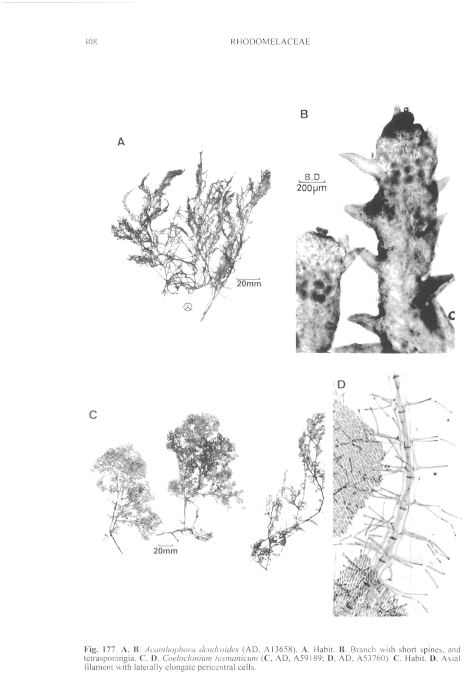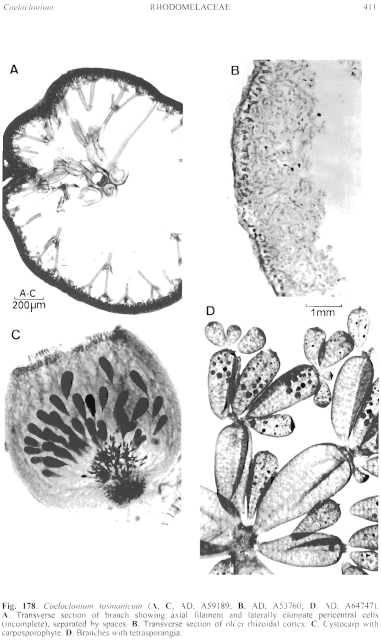|
|
|
|
|
|||||||||||
|
Electronic Flora of South Australia Species Fact Sheet
Phylum Rhodophyta – Family Rhodomelaceae – Tribe Chondrieae
Synonyms
Chylocladia tasmanica Harvey 1844b: 444; 1849a: 81.
Catenella major Sonder 1845: 57; 1848: 171. Kützing 1849: 724; 1866: 25, pl. 72a-c.
Coeloclonium major (Sonder) Silva in Silva et al. 1996: 486.
Rhabdonia sonderi J. Agardh 1851: 356. Sonder 1880: 28.
Chylocladia opuntioides Harvey 1855a: 556.
Chondria opuntioides (Harvey) Harvey 1859b: 297, pl. 189; 1863, synop.: xix.
Tisdall 1898: 512.
Coeloclonium opuntioides (Harvey) J. Agardh 1876: 640. De Toni 1903: 825. Falkenberg 1901: 211, pl. 22 figs 32–34. Guiler 1952: 104. Huisman & Walker 1990: 433. King et al. 1971: 124. Kylin 1956: 549, fig. 439C. Lucas 1909: 40; 1929b: 51. Lucas & Perrin 1947: 256. May 1965: 383. Mazza 1922: No. 783. Reinbold 1898: 49; 1899: 48. Schmitz & Falkenberg 1897: 433, fig. 244C, D. Shepherd & Womersley 1981: 368. Sonder 1880: 29. Tate 1882a: 21. Tisdall 1898: 511. Wilson 1892: 170. Womersley 1950: 187; 1966: 154.
Thallus (Fig. 177C) medium to dark red brown, fading to grey-red, 10–30 cm high, much branched irregularly with axes and main branches bearing lesser branchlets for 2–4 orders, these branchlets appearing as basally constricted segments with rounded apices, often in clusters of 2–4. Axes and main branches 2–4 (–10) mm in diameter, lesser branches clavate (Fig. 178D) to elongate-ovoid, (0.5–) 1–2 mm in diameter and 2–8 mm long. Holdfast discoid or divided; epilithic, occasionally epiphytic. Structure. Apical filaments 8–15 cells long, projecting above the broad rounded apices (due to rapid enlargement of the pericentral cells and their derivatives), apical cells hemispherical, 12–18 µm in diameter. Pericentral cells 5, rapidly elongating (Fig. 177D) at right angles to axial cells thus separated by spaces (Fig. 178A), becoming 90–130 µm in diameter and L/D (1.5–) 4–10, when older bearing short, ovoid cells laterally; pericentral cells apically branched tri- or quadrichotomously for 2–3 orders, cells elongate, with an outer cortex 1–2 cells thick, outer cells mostly ovoid and 10–20 µm in diameter, in longitudinal rows; older branches with an extensive inner cortex of rhizoids (Fig. 178B) cut off from the subcortical cells. Trichoblasts abundant at apices, 0.5–2 mm long. Cells uninucleate; rhodoplasts discoid, chained in larger cells.
Reproduction: Gametophytes dioecious. Procarps not observed. Carposporophytes with a basal cluster of filaments and slight fusion of lower, branched gonimoblast cells, with clavate terminal carposporangia 60–90 µm in diameter. Cystocarps (Fig. 178C) ovoid, sessile, 1–1.5 mm in diameter, lateral on upper branches; pericarp several cells thick, with the erect filaments producing branched derivatives within the cellular cortex. Spermatangial plates not observed.
Tetrasporangia (Fig. 178D) borne on the pericentral cells or their derivatives, few to several per whorl, 120–220 µm in diameter.
Type from Georgetown, Tas. (Gunn 1295); lectotype in Herb. Harvey, TCD.
Selected specimens: 7 mile beach, N of Dongara, W. Aust., drift (Womersley, 17.ix.1979; AD, A51358). Safety Bay, W. Aust., on Amphibolis, drift (Womersley, 23.viii.1947; AD, A5826). Elliston, S. Aust., 4 m deep in bay (Shepherd, 22.x.1970; AD, A37507). Stenhouse Bay, S. Aust., 7 m deep on jetty piles (Gilbert, 15.x.1988; AD, A59189). Marino, S. Aust., drift (Womersley, 22.ix.1945; AD, A1974). Chiton Rocks, S. Aust., 6–10 m deep (Edyvane, 8.viii.1982; AD, A60642). Vivonne Bay, Kangaroo I., S. Aust., 3–4 m deep on jetty piles (Latz, 22.xi.1968; AD, A33029). Muston, Kangaroo I., S. Aust., 2–4 m deep (Womersley, 22.viii.1963; AD, A26857). Stinky Bay, Nora Creina, S. Aust., drift (Womersley, 6.xii.1995; AD, A64747) and 1–3 m deep (Millar, 26.x.1996; AD, A66748). Point Lonsdale, Vic., in pools (Sinkora A935, 8.xi.1970; AD, A62698). Crawfish Rock, Westernport Bay, Vic., 0 m deep (Watson, 29.v.1974; AD, A44418). Walkerville, Vic., in deeper pools (Sinkora A2631, 22.xi.1979; AD, A61031). Low Head, Tas. (Perrin, Jan. 1937; AD, A50200). Bridport, Tas., drift (Parsons & Womersley, 6.xi.1982; AD, A53760). Bruny I., Tas., 14 m deep (Brown, 10.x.1986; AD, A57808).
Distribution: N of Dongara, W. Aust., to Walkerville, Vic., and around Tasmania.
Taxonomic notes: The type specimen of Chylocladia tasmanica in TCD is a poor specimen but recognisable, and Harvey's protologue while expressing reservations is quite recognisable as applying to this common species of Coeloclonium.
Coeloclonium tasmanicum is variable in robustness, the slender specimens occurring in sheltered waters and robust ones on rough-water coasts; it occurs from low tide level to 20 m deep.
References:
AGARDH, J.G. (1851). Species Genera et Ordines Algarum. Vol. 2, Part 1, I-XII, 1–336 + index. (Gleerup: Lund.)
AGARDH, J.G. (1876). Species Genera et Ordines Algarum. Vol. 3, Part 1 - Epicrisis systematis Floridearum, pp. i-vii, 1–724. (Weigel: Leipzig.)
DE TONI, G.B. (1903). Sylloge Algarum omnium hucusque Cognitarum. Vol. 4. Florideae. Sect. 3. pp. 775–1521 + 1523–1525. (Padua.)
FALKENBERG, P. (1901). Die Rhodomelaceen des Golfes von Neapel und der angrenzenden Meeres-abschnitte. Fauna und Flora des Golfes von Neapel. Monogr. 26. (Friedländer: Berlin.)
GUILER, E.R. (1952). The marine algae of Tasmania. Checklist with localities. Pap. Proc. R. Soc. Tasmania 86, 71–106.
HARVEY, W.H. (1844b). Algae of Tasmania. Lond. J. Bot. 3, 428–454.
HARVEY, W.H. (1849a). Nereis Australis, pp. 65–124, Plates 26–50. (Reeve: London.)
HARVEY, W.H. (1855a). Some account of the marine botany of the colony of Western Australia. Trans. R. Jr. Acad. 22, 525–566.
HARVEY, W.H. (1859b). Algae. In Hooker, J.D., The Botany of the Antarctic Voyage. III. Flora Tasmaniae. Vol. II, pp. 282–343, Plates 185–196. (Reeve: London.)
HARVEY, W.H. (1863). Phycologia Australica. Vol. 5, Plates 241–300, synop., pp. i-lxxiii. (Reeve: London.)
HUISMAN, J.M. & WALKER, D.I. (1990). A catalogue of the marine plants of Rottnest Island, Western Australia, with notes on their distribution and biogeography. Kingia 1, 349–459.
KÜTZING, F.T. (1849). Species Algarum. (Leipzig.)
KÜTZING, F.T. (1866). Tabulae Phycologicae. Vol. 16. (Nordhausen.)
KING, R.J., BLACK, J.H. & DUCKER, S. (1971). Port Phillip Bay Survey 2.8. Intertidal ecology of Port Phillip Bay with systematic lists of plants and animals. Mem. Natn. Mus., Vict. 32, 93–128.
KYLIN, H. (1956). Die Gattungen der Rhodophyceen. (Gleerups: Lund.)
LUCAS, A.H.S. & PERRIN, F. (1947). The Seaweeds of South Australia. Part 2. The Red Seaweeds. (Govt Printer: Adelaide.)
LUCAS, A.H.S. (1909). Revised list of the Fucoideae and Florideae of Australia. Proc. Linn. Soc. N.S.W. 34, 9–60.
LUCAS, A.H.S. (1929b). A census of the marine algae of South Australia. Trans. R. Soc. S. Aust. 53, 45–53.
MAY, V. (1965). A census and key to the species of Rhodophyceae (red algae) recorded from Australia. Contr. N.S. W. Natl Herb. 3, 349–429.
MAZZA, A. (1922). Saggio di Algologia Oceanica. Nuova Notarisia 33, Nos. 770–786.
REINBOLD, T. (1898). Die Algen der Lacepede und Guichen Bay (Süd Australien) und deren näherer Umgebung, gesammelt von Dr. A. Engelhart-Kingston. II. Nuova Notarisia 9, 33–54.
REINBOLD, T. (1899). Meeresalgen von Investigator Street (Süd Australien), gesammelt von Miss Nellie Davey (Waltham, Honiton). Hedwigia 38, 39–51.
SCHMITZ, F. & FALKENBERG, P. (1897). Rhodomelaceae. In Engler, A. & Prantl, K., Die natürlichen Pflanzenfamilien. T.1. Abt. 2, pp. 421–480. (Englemann: Leipzig.)
SHEPHERD, S.A. & WOMERSLEY, H.B.S. (1981). The algal and seagrass ecology of Waterloo Bay, South Australia. Aquat. Bot. 11, 305–371.
SILVA, P.C., BASSON, P.W. & MOE, R.L. (1996). Catalogue of the Benthic Marine Algae of the Indian Ocean. (Univ. California Press: Berkeley.)
SONDER, O.G. (1845). Nova Algarum genera et species, quas in itinere ad oras occidentales Novae Hollandiae, collegit L. Preiss, Ph.Dr. Bot. Zeit. 3, 49–57.
SONDER, O.W. (1848). Algae. In Lehmann, C., Plantae Preissianae. Vol. 2, pp. 161–195. (Hamburg.)
SONDER, O.W. (1880). In Mueller, F., Fragmenta Phytographiae Australiae. Supplementum ad volumen undecinum: Algae Australianae hactenus cognitae, pp. 1–42, 105–107. (Melbourne.)
TATE, R. (1882a). A list of the charas, mosses, liverworts, lichens, fungs, and algals of extratropical South Australia. Trans. R. Soc. S. Aust. 4, 5–24.
TISDALL, H.T. (1898). The algae of Victoria. Rep. 7th Meet. Aust. Ass. Adv. Sci., Sydney, 1898, pp. 493–516.
WILSON, J.B. (1892). Catalogue of algae collected at or near Port Phillip Heads and Western Port. Proc. R. Soc. Viet. 4, 157–190.
WOMERSLEY, H.B.S. (1950). The marine algae of Kangaroo Island. III. List of Species 1. Trans. R. Soc. S. Aust. 73, 137–197.
WOMERSLEY, H.B.S. (1966). Port Phillip survey, 1957–1963: Algae. Mem. natl. Mus., Vict. No. 27, 133–156.
The Marine Benthic Flora of Southern Australia Part IIID complete list of references.
Publication:
Womersley, H.B.S. (24 February, 2003)
The Marine Benthic Flora of Southern Australia
Rhodophyta. Part IIID. Ceramiales – Delesseriaceae, Sarcomeniaceae, Rhodomelaceae
Reproduced with permission from The Marine Benthic Flora of Southern Australia Part IIID 2003, by H.B.S. Womersley. Australian Biological Resources Study, Canberra. Copyright Commonwealth of Australia.
Illustrations in Womersley Part IIIA, 2003: FIG. 177C, D, 178.

Figure 177 enlarge
Fig. 177. A, B. Acanthophora dendroides (AD, A13658). A. Habit. B. Branch with short spines, and tetrasporangia. C, D. Coeloclonium tasmanicum (C, AD, A59189; D, AD, A53760). C. Habit. D. Axial filament with laterally elongate pericentral cells.

Figure 178 enlarge
Fig. 178. Coeloclonium tasmanicum (A, C, AD, A59189; B, AD, A53760; D. AD, A64747). A. Transverse section of branch showing axial filament and laterally elongate pericentral cells (incomplete), separated by spaces. B. Transverse section of older rhizoidal cortex. C. Cystocarp with carposporophyte. D. Branches with tetrasporangia.

|
Email Contact: State Herbarium of South Australia |

|